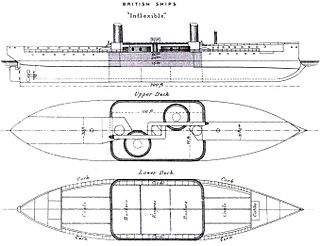 W
WIn a warship an armored citadel is an armored box enclosing the machinery and magazine spaces formed by the armored deck, the waterline belt, and the transverse bulkheads. In many post-World War I warships, armor was concentrated in a very strong citadel, with the rest of the ship virtually unprotected, which was found to be the most effective defence; this is referred to as all or nothing armor.
 W
WA berth is a bed or sleeping accommodation on vehicles. Space accommodations have contributed to certain common design elements of berths.
 W
WThe bilge of a ship or boat is the part of the hull that would rest on the ground if the vessel were unsupported by water. The "turn of the bilge" is the transition from the bottom of a hull to the sides of a hull.
 W
WThe bridge is a room or platform of a ship from which the ship can be commanded. When a ship is under way, the bridge is manned by an officer of the watch aided usually by an able seaman acting as a lookout. During critical maneuvers the captain will be on the bridge, often supported by an officer of the watch, an able seaman on the wheel and sometimes a pilot, if required.
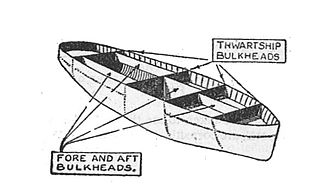 W
WA bulkhead is an upright wall within the hull of a ship or within the fuselage of an aeroplane. Other kinds of partition elements within a ship are decks and deckheads.
 W
WA cabin or berthing is an enclosed space generally on a ship or an aircraft. A cabin which protrudes above the level of a ship's deck may be referred to as a deckhouse.
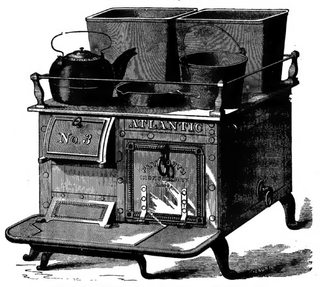 W
WA caboose is a small ship's kitchen, or galley, located on an open deck.
 W
WA cabin or berthing is an enclosed space generally on a ship or an aircraft. A cabin which protrudes above the level of a ship's deck may be referred to as a deckhouse.
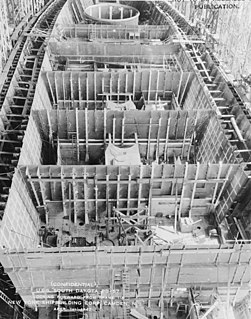 W
WA compartment is a portion of the space within a ship defined vertically between decks and horizontally between bulkheads. It is analogous to a room within a building, and may provide watertight subdivision of the ship's hull important in retaining buoyancy if the hull is damaged. Subdivision of a ship's hull into watertight compartments is called compartmentation.
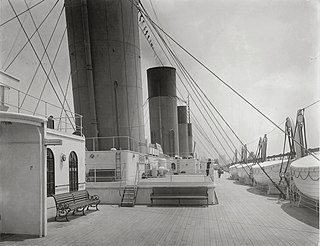 W
WA deck is a permanent covering over a compartment or a hull of a ship. On a boat or ship, the primary or upper deck is the horizontal structure that forms the "roof" of the hull, strengthening it and serving as the primary working surface. Vessels often have more than one level both within the hull and in the superstructure above the primary deck, similar to the floors of a multi-storey building, that are also referred to as decks, as are certain compartments and decks built over specific areas of the superstructure. Decks for some purposes have specific names.
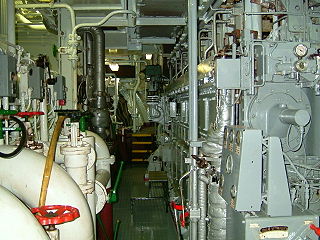 W
WOn a ship, the engine room (ER) is the compartment where the machinery for marine propulsion is located. To increase a vessel's safety and chances of surviving damage, the machinery necessary for the ship's operation may be segregated into various spaces. The engine room is generally the largest physical compartment of the machinery space. It houses the vessel's prime mover, usually some variations of a heat engine. On some ships, there may be more than one engine room, such as forward and aft, or port or starboard engine rooms, or may be simply numbered.
 W
WOn a ship, the fire room, or FR or boiler room or stokehold, referred to the space, or spaces, of a vessel where water was brought to a boil. The steam was then transmitted to a separate engine room, often located immediately aft, where it was utilized to power the vessel. To increase the safety and damage survivability of a vessel, the machinery necessary for operations may be segregated into various spaces, the fire room was one of these spaces, and was among the largest physical compartment of the machinery space. On some ships, the space comprised more than one fire room, such as forward and aft, or port or starboard fire rooms, or may be simply numbered. Each room was connected to a flue, exhausting into a stack ventilating smoke.
 W
WThe forecastle is the upper deck of a sailing ship forward of the foremast, or the forward part of a ship with the sailors' living quarters. Related to the latter meaning is the phrase "before the mast" which denotes anything related to ordinary sailors, as opposed to a ship's officers.
 W
WThe galley is the compartment of a ship, train, or aircraft where food is cooked and prepared. It can also refer to a land-based kitchen on a naval base, or, from a kitchen design point of view, to a straight design of the kitchen layout.
 W
WA gangway is a narrow passage that joins the quarterdeck to the forecastle of a sailing ship. The term is also extended to mean the narrow passages used to board or disembark ships.
 W
WThe term gun deck used to refer to a deck aboard a ship that was primarily used for the mounting of cannon to be fired in broadsides. The term is generally applied to decks enclosed under a roof; smaller and unrated vessels carried their guns on the upper deck, forecastle and quarterdeck, and these were not described as gun decks.
 W
WA gunroom is the junior officers' mess on a naval vessel. It was occupied by the officers below the rank of lieutenant. In the wooden sailing ships it was on the lower deck, and was originally the quarters of the gunner, but in its form as a mess, guns were not normally found in it. The senior officers' equivalent is the wardroom.
 W
WThe head is a ship's toilet. The name derives from sailing ships in which the toilet area for the regular sailors was placed at the head or bow of the ship.
 W
WThe lazarette of a boat is an area near or aft of the cockpit. The word is similar to and probably derived from lazaretto. A lazarette is usually a storage locker used for gear or equipment a sailor or boatswain would use around the decks on a sailing vessel.
 W
WMagazine is the name for an item or place within which ammunition or other explosive material is stored. It is taken originally from the Arabic word "makhāzin" (مخازن), meaning storehouses, via Italian and Middle French.
 W
WThe bridge is a room or platform of a ship from which the ship can be commanded. When a ship is under way, the bridge is manned by an officer of the watch aided usually by an able seaman acting as a lookout. During critical maneuvers the captain will be on the bridge, often supported by an officer of the watch, an able seaman on the wheel and sometimes a pilot, if required.
 W
WA combat information center (CIC) or action information centre (AIC) is a room in a warship or AWACS aircraft that functions as a tactical center and provides processed information for command and control of the near battlespace or area of operations. Within other military commands, rooms serving similar functions are known as command centers.
 W
WThe orlop is the lowest deck in a ship. It is the deck or part of a deck where the cables are stowed, usually below the water line.
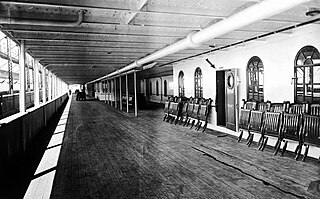 W
WThe promenade deck is a deck found on several types of passenger ships and riverboats. It usually extends from bow to stern, on both sides, and includes areas open to the outside, resulting in a continuous outside walkway suitable for promenading, thus the name.
 W
WThe quarterdeck is a raised deck behind the main mast of a sailing ship. Traditionally it was where the captain commanded his vessel and where the ship's colours were kept. This led to its use as the main ceremonial and reception area on board, and the word is still used to refer to such an area on a ship or even in naval establishments on land. Many such facilities have areas decorated like shipboard quarterdecks.
 W
WA safe room or panic room is a fortified room that is installed in a private residence or business to provide a safe shelter, or hiding place, for the inhabitants in the event of a break in, home invasion, tornado, terror attack, or other threat. Safe rooms usually contain communications equipment, so that law enforcement authorities can be contacted.
 W
WA sick bay is a compartment in a ship, or a section of another organisation, such as a school or college, used for medical purposes.
 W
WA superstructure is an upward extension of an existing structure above a baseline. This term is applied to various kinds of physical structures such as buildings, bridges, or ships having the degree of freedom zero.
 W
WIn traditional nautical use, well decks were decks lower than decks fore and aft, usually at the main deck level, so that breaks appear in the main deck profile, as opposed to a flush deck profile. The term goes back to the days of sail. Late-20th-century commercial and military amphibious ships have applied the term to an entirely different type of hangar-like structure, evolving from exaggerated deep "well decks" of World War II amphibious vessels, that can be flooded for lighters or landing craft.
 W
WIn modern amphibious warfare usage, a well dock or well deck, officially termed a wet well in U.S. Navy instructions when the well deck is flooded for operations, is a hangar-like deck located at the waterline in the stern of some amphibious warfare ships. By taking on water the ship can lower its stern, flooding the well deck and allowing boats, amphibious vehicles and landing craft to dock within the ship.